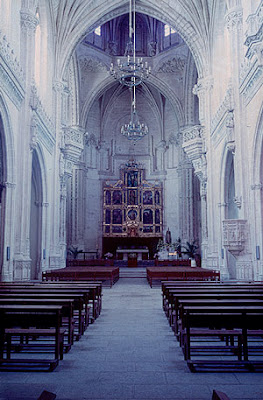"Pope attacks 'cruel and unjust' atheism in his message of hope
By
Richard Owen of The Times, in Rome
The Pope launched an attack on atheism today, saying that it had led to some of the “greatest forms of cruelty and violations of justice” known to mankind.
In his second encyclical, Spe Salvi (Saved By Hope) Pope Benedict said that atheism purported to be “a type of moralism, a protest against the injustices of the world and of world history”. Atheists argued that “a world marked by so much injustice, innocent suffering and cynicism of power cannot be the work of a good God”.
Since there was “no God to create justice”, atheists said, Man himself was called on to establish it on earth. This protest against God was “understandable”, the Pope said, but “the claim that humanity can and must do what no God actually does or is able to do is both presumptuous and intrinsically false”.
Benedict added: “It is no accident that this idea has led to the greatest forms of cruelty and violations of justice: rather is is grounded in the intrinsic falsity of the claim. A world which has to create its own justice is a world without hope.”
He did not single out any modern atheists by name.
The Pope said that faith in progress through science was also illusory. While there had been great scientific advances for mankind offering “new possibilites for good”, science also “opens up appalling possibilities for evil, possibilities that did not formerly exist. We have all witnessed the way in which progress, in the wrong hands, can become and has indeed has become a terrifying progress in evil.”
He also said that Christianity itself had ignored Christ's message that true Christian hope involves salvation for all, focusing instead on indiviudual salvation.
“We must do all we can to overcome suffering, but to banish it from the world is not in our power,” the Pope wrote. “Only God is able to do this.” He added: “Heaven is not empty,” and that Paradise and Hell were real places, not myths.
In the 76-page document, peppered with scholarly and theological references but written in a clear, limpid style Benedict argues that the modern world was shaped by the French Revolution of 1789 and the Russian Revolution of 1917, the latter inspired by the ideas of Karl Marx. He praised Marx's “acute analysis” and “precision” in describing his times.
But Marx's “fundamental error” was that he “showed precisely how to overthrow the existing order but did not say how matters should proceed thereafter”. This has led to the Soviet system and other horrors of the 20th century. Marxism, the Pope wrote, had left behind “a trail of appalling destruction” because it failed to realise that Man could not be “merely the product of economic conditions”.
The encyclical takes its Latin title from St Paul's Letter to the Romans in the New Testament. An encyclical is the most authoritative statement a Pope can issue to the faithful.
Cardinal Albert Vanhoye, a Vatican biblical scholar, who presented the document, said that it was addressed not only to Catholics but also to Protestants and Orthodox Christians and even to non-Christians. He noted that it had been signed and released on the feast of St Andrew, which is celebrated with particular devotion by the Orthodox Church.
The Pope, who has shown increasing concern over global warming and other “green” issues, said that “Christian hope” also meant protecting the planet.
“We can free our life and the world from the poisons and contaminations that could destroy the present and the future. We can uncover the sources of Creation and keep them unsullied, and in this way we can make a right use of creation, which comes to us as a gift,” he said.
Benedict's first encyclical, Deus Caritas Est (God is Love), issued in January 2006, was on erotic and spiritual love (“charity”). Asked if the Pope was working on a third encyclical on “faith” to complete a trilogy on faith, hope and charity, Father Federico Lombardi, his spokesman, said that this was “not excluded”.
The Pope, who was elected in 2005, is also working on another encyclical on the theme of social justice in an era of globalisation, to be released next Easter.
In Spe Salvi he quotes St Augustine, St Bernard and Sister Josephine Bakhita, a former Sudanese slave who in the 19th century was rescued by an Italian priest and became a nun and was later canonised by Pope John Paul II as a “symbol of hope”. He also quotes secular thinkers, from Plato to Francis Bacon and the German Marxist philosopher Theodor Adorno.
In the document the Pope says: “A distinguishing mark of Christians is the fact that they have a future: they know that their life will not end in emptiness.”
He says that redemption “is offered to us in the sense that we have been given hope, trustworthy hope, by virtue of which we can face our present, even if it is arduous, can be lived and accepted if it leads towards a goal”.
Jesus did not bring a message of social revolution like the Roman slave Spartacus, he says, “he brought something totally different, an encounter with the living God, an encounter with a hope stronger than the sufferings of slavery, a hope which therefore transformed life and the world from within, even if external structures remained unaltered.” Jesus showed us “the way beyond death”.
The Pope says many people reject faith today, “simply because they do not find the prospect of eternal life attractive. What they desire is not eternal life at all, but this present life, for which faith in eternal life seems something of an impediment.”
He concludes: “Our hope is essentially also hope for others: only thus is it truly hope for me too.”


























































